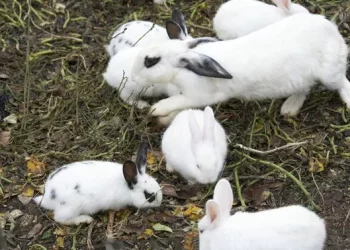Flemish Giant rabbits are known for their impressive size, gentle temperament, and unique appearance. As one of the largest rabbit breeds, they require a carefully balanced diet to support their growth, health, and longevity. In this article, we will explore the dietary needs of Flemish Giant rabbits in detail, covering the essential components of their diet, feeding guidelines, common mistakes, and additional considerations for keeping these majestic animals healthy.
1. Introduction to Flemish Giant Rabbits
Flemish Giant rabbits originated in Belgium and have been bred for their size and meat quality since the early 19th century. These rabbits can weigh between 14 to 20 pounds and can reach lengths of over 2.5 feet. Despite their size, they are known for their friendly and sociable nature, making them excellent pets for families and individuals alike.
Given their size and unique needs, it is crucial to provide them with a well-balanced diet. This article will provide a comprehensive guide on what to feed Flemish Giant rabbits, ensuring they thrive as pets.
2. Understanding the Nutritional Needs of Flemish Giant Rabbits
Basic Nutritional Requirements
Flemish Giant rabbits, like all rabbits, are herbivores. Their diet must be rich in fiber, low in protein, and include a variety of nutrients. The primary components of a healthy rabbit diet include:
Fiber: Essential for digestive health, fiber helps prevent gastrointestinal issues and keeps the gut flora balanced.
Protein: While rabbits need protein, the amount should be limited to avoid obesity and related health problems. A protein content of 12-14% is usually ideal for adult Flemish Giants.
Carbohydrates: Carbohydrates should be provided primarily through high-quality hay and fresh vegetables, while grains should be given sparingly.
Vitamins and Minerals: Essential for overall health, including bone development and immune function.
Hay: The Foundation of a Flemish Giant’s Diet
Hay is the cornerstone of a Flemish Giant rabbit‘s diet. It provides the necessary fiber that aids in digestion and keeps their teeth healthy. The best types of hay for Flemish Giants include:
Timothy Hay: This is the most commonly recommended hay for rabbits. It is high in fiber and low in protein, making it an excellent choice.
Orchard Grass Hay: Another great option, orchard grass hay is softer and sweeter than timothy hay, which can be more appealing to some rabbits.
Meadow Hay: This type of hay includes various grasses and plants, providing a diverse range of nutrients.
It is essential to provide unlimited access to hay daily. Flemish Giant rabbits should consume hay throughout the day to maintain proper digestive function.
Fresh Vegetables: A Source of Vitamins and Nutrients
Fresh vegetables can complement a Flemish Giant’s diet, providing essential vitamins, minerals, and hydration. However, not all vegetables are suitable for rabbits. Here are some safe options:
Leafy Greens: Romaine lettuce, kale, parsley, cilantro, and Swiss chard are excellent choices. These should be introduced gradually to avoid digestive upset.
Root Vegetables: Carrots, beets, and radishes can be offered in moderation. While rabbits enjoy the sweetness, they should not make up a large portion of the diet due to their higher sugar content.
Other Vegetables: Bell peppers, cucumbers, and zucchini can be provided as treats.
Fresh vegetables should make up about 10-20% of a Flemish Giant’s diet, and it’s important to introduce new vegetables slowly to monitor for any adverse reactions.
Pellets: A Supplement to the Diet
Commercial rabbit pellets can be used to supplement the diet, but they should not be the primary food source. When choosing pellets, look for:
High-Quality Pellets: Select pellets that contain at least 18% fiber and are free from seeds, nuts, and added sugars.
Limited Quantity: Adult Flemish Giants should receive about 1/4 to 1/2 cup of pellets daily, depending on their size and activity level. Young Flemish Giants may require more to support their growth.
Treats: What to Avoid
While treats can be an enjoyable addition to your Flemish Giant’s diet, it’s essential to choose them wisely. Avoid sugary or high-fat treats such as:
Fruits: While fruits like apples and bananas can be given sparingly, they are high in sugar and should only be offered in small amounts (a couple of times per week).
Commercial Rabbit Treats: Many store-bought treats are high in sugar and additives. Always read labels and opt for natural options when possible.
3. Feeding Guidelines for Flemish Giant Rabbits
Daily Feeding Schedule
Establishing a consistent feeding schedule can help maintain your Flemish Giant’s health. Here’s a suggested daily routine:
Morning: Offer fresh hay and a small portion of pellets. Introduce a variety of leafy greens.
Afternoon: Refresh hay and provide additional vegetables as treats.
Evening: Ensure hay is available and check if more pellets are needed.
Monitoring Portion Sizes
To prevent obesity, it’s crucial to monitor portion sizes. Flemish Giants are prone to weight gain, which can lead to health issues. Use a kitchen scale to weigh food portions initially, adjusting as needed based on your rabbit’s activity level and body condition.
Providing Fresh Water
Fresh, clean water should always be available. Rabbits can become dehydrated quickly, so it’s essential to check their water supply regularly and change it daily. Use a heavy water bowl or a water bottle designed for rabbits to prevent spills.
4. Common Dietary Mistakes
Feeding a Flemish Giant rabbit can come with its share of challenges. Here are some common mistakes to avoid:
Overfeeding Pellets
While pellets can be a convenient source of nutrients, they should not be the mainstay of your rabbit’s diet. Overfeeding can lead to obesity and associated health issues. Stick to the recommended portions and ensure hay is the primary food source.
Inadequate Hay Intake
Rabbits need unlimited access to hay for optimal digestive health. If your Flemish Giant is not consuming enough hay, it can lead to gastrointestinal problems and dental issues. Always provide fresh hay and monitor your rabbit’s intake.
Sudden Dietary Changes
Rabbits have sensitive digestive systems, and sudden changes in diet can lead to digestive upset. Introduce new foods gradually, monitoring your rabbit for any signs of discomfort, such as bloating or changes in fecal output.
5. Special Considerations for Flemish Giant Rabbits
Dietary Needs During Different Life Stages
Flemish Giant rabbits have varying dietary needs at different life stages:
Baby Flemish Giants: Kits (baby rabbits) should be fed their mother’s milk until they are about 6-8 weeks old. After weaning, they can start eating hay and pellets designed for young rabbits.
Young Rabbits: Between 8 weeks and 6 months, young Flemish Giants require a higher protein diet to support their rapid growth. Offer unlimited hay, pellets formulated for growing rabbits, and gradually introduce fresh vegetables.
Adult Rabbits: After 6 months, switch to a maintenance diet consisting of unlimited hay, a limited amount of high-fiber pellets, and a variety of vegetables.
Senior Rabbits: Older rabbits may have specific dietary needs. Consult a veterinarian for tailored recommendations, as they may require easier-to-chew foods or adjustments based on health conditions.
Health Conditions Related to Diet
Certain health issues can arise from improper feeding:
Obesity: Overfeeding pellets and treats can lead to obesity, which increases the risk of heart disease and other health problems.
Dental Issues: A lack of hay can lead to overgrown teeth, causing pain and difficulty eating.
Gastrointestinal Stasis: An imbalanced diet low in fiber can cause gastrointestinal stasis, a serious condition requiring immediate veterinary attention.
The Importance of Regular Veterinary Care
Regular veterinary check-ups are crucial for ensuring the health of your Flemish Giant rabbit. Discuss your rabbit’s diet during these visits and seek advice on any specific concerns.
Conclusion
Feeding a Flemish Giant rabbit requires careful consideration and a commitment to providing a balanced, nutritious diet. By prioritizing hay, fresh vegetables, and appropriate pellets, you can ensure your rabbit remains healthy and happy. Remember that every rabbit is unique, so observing their preferences and behaviors can guide you in tailoring their diet effectively.
By following the guidelines outlined in this article, you can help your Flemish Giant thrive for years to come, allowing you to enjoy the companionship of this gentle giant. Always remember that a well-fed rabbit is a happy rabbit, and providing the right diet is one of the best ways to show your love and care for your furry friend.
Related Topics:



























